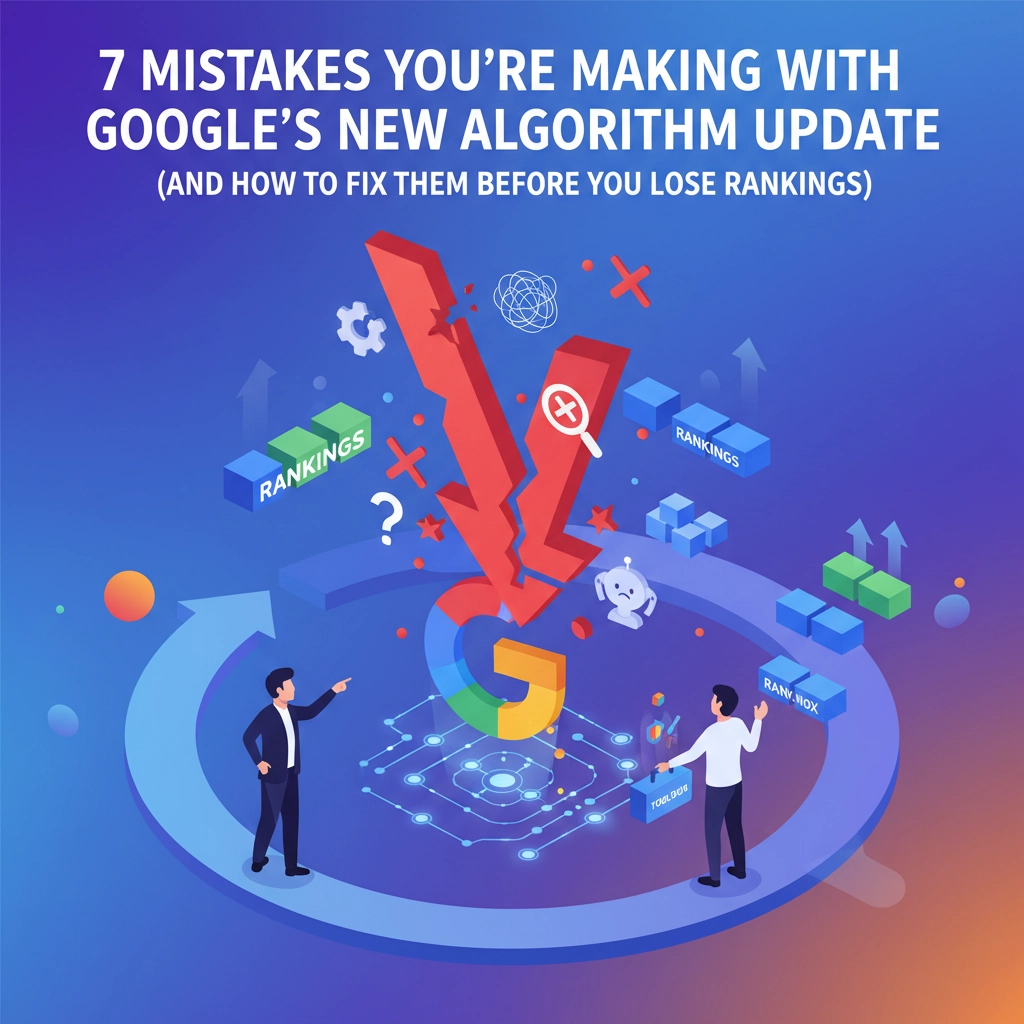
Google’s October 2025 algorithm updates have sent shockwaves through the digital marketing world, causing significant ranking fluctuations across industries. If you’ve noticed drops in your organic traffic or search visibility, you’re not alone: and more importantly, you’re likely making one of seven critical mistakes that the new algorithm heavily penalizes.
The good news? These mistakes are entirely fixable when you know what to look for and how to address them systematically. Let’s examine each mistake and provide you with actionable solutions to protect and recover your rankings.
Mistake #1: Publishing Thin, Low-Value Content
The October 2025 core algorithm update has dramatically raised the bar for content quality. Google now aggressively penalizes websites that publish thin content designed solely to capture search traffic without providing genuine value to users.
What This Looks Like:
- Blog posts under 300 words that barely scratch the surface of topics
- Pages created solely to target specific keywords without comprehensive information
- Content that doesn’t fully answer the user’s search intent
- Duplicate or near-duplicate content across multiple pages

The Fix:
Conduct a comprehensive content audit immediately. Review every page on your website and identify content that falls short of providing substantial value. For thin content, you have three options:
- Expand and enhance existing content with detailed, authoritative information
- Consolidate multiple thin pages into comprehensive resource pages
- Remove pages that cannot be improved and serve no strategic purpose
Focus on creating content that thoroughly addresses user intent. Each page should provide complete answers to the questions your audience is asking, backed by expertise and real-world insights.
Mistake #2: Relying on Manipulative SEO Tactics
Google’s spam detection algorithms have become extraordinarily sophisticated, targeting websites that employ deceptive practices to manipulate search rankings.
Common Manipulative Tactics:
- Keyword stuffing in content, meta descriptions, and alt tags
- Cloaking content to show different versions to users versus search engines
- Using misleading clickbait headlines that don’t match page content
- Building low-quality backlinks from irrelevant or spammy websites
The Fix:
Immediately audit your website for any manipulative practices:
- Remove hidden text and excessive keyword repetition
- Replace misleading headlines with accurate, compelling titles
- Focus on natural language that serves users first
- Disavow harmful backlinks and focus on earning high-quality links from relevant sources
Remember: sustainable SEO success comes from providing genuine value, not gaming the system.
Mistake #3: Ignoring E-A-T Signals (Expertise, Authority, Trustworthiness)
The October 2025 updates place unprecedented weight on E-A-T signals, particularly for websites in competitive or sensitive industries. Without clear demonstrations of expertise and authority, your content will struggle to rank competitively.
Missing E-A-T Elements:
- Lack of author credentials and expertise indicators
- Absence of trust signals like testimonials and certifications
- No clear demonstration of industry authority
- Missing contact information and business verification

The Fix:
Strengthen your E-A-T profile systematically:
- Create detailed author bios that establish credentials and expertise
- Display certifications, awards, and professional affiliations prominently
- Build high-quality backlinks from authoritative industry websites
- Showcase customer testimonials and case studies that demonstrate results
- Ensure your content is written or reviewed by subject matter experts
- Make your business information transparent with clear contact details and verification
Mistake #4: Neglecting Mobile Optimization
With mobile-first indexing fully implemented, any website not optimized for mobile devices faces severe ranking penalties. The October 2025 updates have made mobile performance a critical ranking factor.
Mobile Optimization Issues:
- Slow page load speeds on mobile devices
- Unresponsive design that doesn’t adapt to different screen sizes
- Content that’s difficult to read or interact with on mobile
- Forms and buttons that are hard to use on touchscreens
The Fix:
Ensure complete mobile optimization:
- Test your website on multiple mobile devices and screen sizes
- Optimize page load speeds by compressing images and minimizing code
- Implement responsive design that adapts seamlessly across all devices
- Use Google’s Mobile-Friendly Test to identify and fix specific issues
- Prioritize mobile user experience in all design and development decisions
Mistake #5: Failing to Optimize for AI-Powered Search
Google’s AI Mode integration represents a fundamental shift in how search results are delivered. If your content isn’t structured for AI comprehension and extraction, you’re missing crucial visibility opportunities.
AI Optimization Gaps:
- Content that doesn’t provide direct, clear answers to common questions
- Lack of structured data and schema markup
- Information that’s difficult for AI systems to parse and summarize
- Absence of FAQ sections and question-based content

The Fix:
Structure your content for AI-powered search:
- Create comprehensive FAQ sections that address common user questions
- Implement schema markup to help AI systems understand your content structure
- Use clear headings and subheadings that organize information logically
- Provide direct answers to questions within your content
- Format information in lists and bullet points for easy AI extraction
Mistake #6: Making Critical Local SEO Errors
The October 2025 updates include significant changes to local search algorithms, making local SEO mistakes particularly costly for businesses targeting geographic markets.
Common Local SEO Mistakes:
- Inconsistent Name, Address, Phone (NAP) information across platforms
- Review gating (only asking satisfied customers for reviews)
- Using AI-generated images that undermine credibility
- Neglecting Google My Business optimization
- Failing to target location-specific keywords
The Fix:
Optimize your local SEO strategy:
- Ensure NAP consistency across all online directories and platforms
- Optimize your Google My Business listing completely with accurate information, photos, and regular updates
- Encourage all customers to leave genuine reviews, not just satisfied ones
- Use authentic, original photography instead of generic or AI-generated images
- Create location-specific content that speaks directly to your geographic market
- Target local keywords naturally within your content
Mistake #7: Ignoring Performance Monitoring and Response
Many websites fail to monitor their performance after algorithm updates, missing opportunities to quickly identify and address issues before significant damage occurs.
Monitoring Failures:
- Not tracking organic traffic and keyword rankings regularly
- Failing to set up alerts for significant performance changes
- Ignoring Search Console warnings and notifications
- Not updating content regularly to maintain competitiveness

The Fix:
Establish comprehensive performance monitoring:
- Set up Google Analytics and Search Console to track organic performance
- Monitor keyword rankings for your most important terms
- Establish email alerts for significant traffic or ranking changes
- Review performance data weekly to identify trends and issues
- Create a content refresh schedule to keep information current and competitive
- Respond quickly to algorithm updates with data-driven adjustments
Taking Action: Your Next Steps
The October 2025 algorithm updates represent Google’s commitment to rewarding websites that prioritize user experience, expertise, and genuine value. By addressing these seven critical mistakes, you’ll align your website with Google’s current priorities and build a more sustainable SEO foundation.
Prioritize your fixes in this order:
- Address any manipulative SEO tactics immediately
- Audit and improve thin or low-value content
- Strengthen E-A-T signals across your website
- Ensure complete mobile optimization
- Optimize for AI-powered search features
- Fix local SEO issues if applicable
- Implement ongoing performance monitoring
Remember, algorithm recovery takes time. Focus on making systematic improvements rather than quick fixes, and monitor your progress consistently.
Want a personalized SEO audit or recovery strategy? Email robert@digitaltrafficfactory.com or call 203-217-9496 and let’s protect your rankings together!
